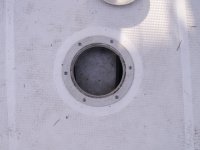You are using an out of date browser. It may not display this or other websites correctly.
You should upgrade or use an alternative browser.
You should upgrade or use an alternative browser.
Need to Re-caulk Cockpit Floor
- Thread starter Pat Anderson
- Start date
captd
New member
- Joined
- Nov 6, 2003
- Messages
- 514
- Reaction score
- 0
- C Dory Year
- 1994
- C Dory Model
- 22 Cruiser
- Vessel Name
- Kon Tiki
Has anyone ever figured out how , when using 5200 that some always ends up in your hair.
I would think that is the stuff to do a deck job with. Not only an adhessive but also a sealer. The best to put on, the worst to take off.
Captd
I would think that is the stuff to do a deck job with. Not only an adhessive but also a sealer. The best to put on, the worst to take off.
Captd
Grumpy
Active member
- Joined
- Oct 10, 2005
- Messages
- 1,607
- Reaction score
- 0
- Vessel Name
- Kingfisher II
I have discovered, (by installer error, not mine) that trim tab hydraulic fluid "eats" 5200.
Someone who shall not be named had filled the transom hole with 5200 (no epoxy) and fogotten to completely tighten the nipple. When I pulled it apart after 1 year to check if epoxy had been used,I found that the 5200 was completely debonded and largely reduced to a pinkish "goo".
Not recommending it as a remover but it is definitely worth checking all the transom holes especially if you are "losing " hydualic fluid and cannot see any trace of it except perhaps a mysterious sheen on the water now and again.
Merv
Someone who shall not be named had filled the transom hole with 5200 (no epoxy) and fogotten to completely tighten the nipple. When I pulled it apart after 1 year to check if epoxy had been used,I found that the 5200 was completely debonded and largely reduced to a pinkish "goo".
Not recommending it as a remover but it is definitely worth checking all the transom holes especially if you are "losing " hydualic fluid and cannot see any trace of it except perhaps a mysterious sheen on the water now and again.
Merv
drjohn71a
New member
- Joined
- Jul 15, 2004
- Messages
- 1,820
- Reaction score
- 0
- C Dory Year
- 2007
- C Dory Model
- 255 Tomcat
- Vessel Name
- Tom-a-Hawk
Pat,
I'm just tossing in an idea here which needs to be bandied around before you actually do it, BUT I wonder if a "Hot Knife" or hot wire, or woodburner type, light sweep of the seam would allow you to remove enough to caulk over. Maybe you don't need to remove all the deepest parts of the material in order to cover over it.
Just a crazy though here... I've used heat tools to remove caulking before. The problem with hot air is that it heats a broad area. Maybe a mini-torch?
Oh well,,, good luck, I hope you find an answer before I have to recaulk mine!
John
I'm just tossing in an idea here which needs to be bandied around before you actually do it, BUT I wonder if a "Hot Knife" or hot wire, or woodburner type, light sweep of the seam would allow you to remove enough to caulk over. Maybe you don't need to remove all the deepest parts of the material in order to cover over it.
Just a crazy though here... I've used heat tools to remove caulking before. The problem with hot air is that it heats a broad area. Maybe a mini-torch?
Oh well,,, good luck, I hope you find an answer before I have to recaulk mine!
John
thataway
Well-known member
- Joined
- Nov 2, 2003
- Messages
- 21,695
- Reaction score
- 69
- C Dory Year
- 2007
- C Dory Model
- 25 Cruiser
- Hull Identification Number
- DOR25652A707
- Vessel Name
- thataway
A Weller soldering iron can use a Hot kinfe tip--flat about 3/8 " diameter. about 1/16 inch thick.
There are some structural adhesives which are silicone and almost impossiable to get off.
I would call C Dory and find out what was used, or susposed to be used.
Try some of the debond and see what happens.
Good luck--and thanks for sharing...
There are some structural adhesives which are silicone and almost impossiable to get off.
I would call C Dory and find out what was used, or susposed to be used.
Try some of the debond and see what happens.
Good luck--and thanks for sharing...
Cured 3M marine adhesive/sealant 5200
can be removed mechanically with a knife, razor blade, piano wire or sanding.
Better buy some leather gloves and Band-Aids
http://multimedia.mmm.com/mws/mediawebs ... T8COrrrrQ-
can be removed mechanically with a knife, razor blade, piano wire or sanding.
Better buy some leather gloves and Band-Aids
http://multimedia.mmm.com/mws/mediawebs ... T8COrrrrQ-
Sea Wolf
New member
- Joined
- Nov 1, 2003
- Messages
- 8,650
- Reaction score
- 0
- C Dory Year
- 1987
- C Dory Model
- 22 Cruiser
- Hull Identification Number
- DOR22286A787
- Vessel Name
- Sea Wolf
Pat and Patty-
my friend, Swami:

sez to go to your local tool rental outfit in Snoquolamie Falls and rent some high-powered construction equipment and give you son Austin and his friends some valuable pre-college education in the value of a college diploma and graduate school.....









Joe. :wink (Thought some humor would be nice to cheer you and Patty up!)
my friend, Swami:

sez to go to your local tool rental outfit in Snoquolamie Falls and rent some high-powered construction equipment and give you son Austin and his friends some valuable pre-college education in the value of a college diploma and graduate school.....









Joe. :wink (Thought some humor would be nice to cheer you and Patty up!)
Attachments
-
 Man_with_jackhammer_5.gif5.4 KB · Views: 0
Man_with_jackhammer_5.gif5.4 KB · Views: 0 -
 Man_with_jackhammer_5.gif5.4 KB · Views: 0
Man_with_jackhammer_5.gif5.4 KB · Views: 0 -
 Man_with_jackhammer_5.gif5.4 KB · Views: 0
Man_with_jackhammer_5.gif5.4 KB · Views: 0 -
 Man_with_jackhammer_5.gif5.4 KB · Views: 0
Man_with_jackhammer_5.gif5.4 KB · Views: 0 -
 Man_with_jackhammer_5.gif5.4 KB · Views: 0
Man_with_jackhammer_5.gif5.4 KB · Views: 0 -
 Man_with_jackhammer_5.gif5.4 KB · Views: 0
Man_with_jackhammer_5.gif5.4 KB · Views: 0 -
 Man_with_jackhammer_5.gif5.4 KB · Views: 0
Man_with_jackhammer_5.gif5.4 KB · Views: 0 -
 Man_with_jackhammer_5.gif5.4 KB · Views: 0
Man_with_jackhammer_5.gif5.4 KB · Views: 0
Pat Anderson
New member
- Joined
- Nov 2, 2003
- Messages
- 8,562
- Reaction score
- 0
- C Dory Year
- 2005
- C Dory Model
- 25 Cruiser
- Vessel Name
- Daydream
OK, progress report! The cockpit floor over the gas tank is OUT as of about 20 minutes ago! Whatever the evil stuff C-Dory used was, it was susceptible to softening by heat - hair dryer trick worked well enough to let us dig the junk out!
I now know two more facts: A, the floor was not installed backwards - the inspection hatch is not over the sender unit no matter which way the floor is installed, and 2, the aluminum gas tank is sitting directly on the sole with no apparent support (there MIGHT be a small piece under it, but it is not up off the sole to keep it out of the bilge water). So I think C-Dory should give us a new floor with a properly placed hatch that allows access to the sender unit. I am not sure about the gas tank, is this a big problem? Is it likely to corrode sitting on the sole?
I now know two more facts: A, the floor was not installed backwards - the inspection hatch is not over the sender unit no matter which way the floor is installed, and 2, the aluminum gas tank is sitting directly on the sole with no apparent support (there MIGHT be a small piece under it, but it is not up off the sole to keep it out of the bilge water). So I think C-Dory should give us a new floor with a properly placed hatch that allows access to the sender unit. I am not sure about the gas tank, is this a big problem? Is it likely to corrode sitting on the sole?
Ok Ok Im here Pat =). 5200 is what has always been applied to the 25 floors. I will tell you a very easy way to clean it though. We applied that sealant knowing that most of the boats were in saltwater and normal silicone will flake away. I believe most of the boats have a raw water washdown used as well. The stuff we used to clean it was a 3m * CITRUS* cleaner. If that doesn't work you know where to find me and maybe I can help you get it looking good enough where you don't have to remove it. The other way is the use a razor knife and cut it all the way around and remove the floor out. (Probably wouldn't hurt to get a good visual of how the tanks and everything look as well). Once you get it out squirt that citrus all over and use one of those scraper razor knives just to get the top edge and re- seal it. You know you are welcome to call me at ANYTIME Pat so don't hesitate with any questions![/b]
Pat Anderson
New member
- Joined
- Nov 2, 2003
- Messages
- 8,562
- Reaction score
- 0
- C Dory Year
- 2005
- C Dory Model
- 25 Cruiser
- Vessel Name
- Daydream
Thanks, Andrew, for confirming that the cockpit floor was sealed / glued in with 3M 5200. The caulking was way beyond cleaning - the bead was full of black mold (mildew?) and was cracking. Plus I wanted to see if turning the floor around would expose the gas gauge sender unit under the inspection hatch (it didn't) and how the gas tank was supported (at first glance, in the dark, it appeared to be simply resting on the sole). I will look again closely in the daylight to see if there are rubber strips or something under the gas tank, and will post some pix. We will NOT be re-gluing the cockpit floor down. We will screw it back in place and use the BoatLife Life-Calk to just caulk the seams - can you give us some insight on why the floor was glued in place with 5200? Sure made it the devil to remove...
Lucky Day
New member
- Joined
- Oct 10, 2006
- Messages
- 215
- Reaction score
- 0
- C Dory Year
- 2004
- C Dory Model
- 25 Cruiser
- Vessel Name
- Lucky Day
Is there a way to confirm whether or not the fuel tank on an '04 25 is resting on the sole and needs support of some kind added -- using just the access port over the sender? Or does the cockpit floor need to be opened up in order to inspect it?
Pat Anderson
New member
- Joined
- Nov 2, 2003
- Messages
- 8,562
- Reaction score
- 0
- C Dory Year
- 2005
- C Dory Model
- 25 Cruiser
- Vessel Name
- Daydream
Somebody correct me if I am wrong, but I am pretty sure the only way to see how the gas tank is supported is to pull the cockpit floor - I will post some pix today or tomorrow since I have the floor off right now. I assume there are rubber strips, as Andrew says there are supposed to be, but I will confirm that this evening.
Lucky Day":3c7k9yy4 said:Is there a way to confirm whether or not the fuel tank on an '04 25 is resting on the sole and needs support of some kind added -- using just the access port over the sender? Or does the cockpit floor need to be opened up in order to inspect it?
thataway
Well-known member
- Joined
- Nov 2, 2003
- Messages
- 21,695
- Reaction score
- 69
- C Dory Year
- 2007
- C Dory Model
- 25 Cruiser
- Hull Identification Number
- DOR25652A707
- Vessel Name
- thataway
The tank definately needs to be off the floor--not just chafing, but to keep it from sitting in salt water (the reason that aluminum tanks fail).
From David Pascoe: http://www.yachtsurvey.com/fueltank.htm
"you are going to set the tank on top of 1/4" strips of plastic about 2" wide and spaced about every 12". Its best to place the strips transversly to the length of the tank. We recommend Haysite or any of the fiber reinforced plastic sheet. The strips should be cut to a length exactly 1/4" shorter than the width of the tank. We don't want the strips sticking out the sides and collecting water.
Apply the adhesive so that the entire surface of the plastic is coated with 5200 and will not leave any gaps or crevices for water to get into. Once the strips are pressed into position, make sure that the ends are equally 1/8' from the edges of the tank. Wipe off the excess 5200 that squeezes out, making sure that the joint between tank and plastic strip is completely sealed. Don't leave any globs of material.
Allow 24 hours for the 5200 to set up before setting the tank in place. Next, apply two 1/4" wide beads (like a stream of tooth paste) of 5200 along the length of each plastic strips that are now glued to the bottom of the tank. The strips do not get fully bedded because tanks expand and contract as they are filled and emptied. If the bottom distorts, we want the plastic strips to loosen from the deck, not the bottom of the tank."
Mr Pascoe also states:
"Do not use rubber strips: rubber contains carbon, which is cathodic to aluminum and will cause galvanic corrosion. "
All of David Pascoe's threads are definately worth reading, even if you think he is too "strick".
I don't know how the tank is put in place, but with the top off, it might be well worth while to take a look at it, how it is fixed in place and to make sure it is properly secured. I would think that the inspection plate should be over the sender unit, and the draw tube also be easily accessable.
Bob Austin
From David Pascoe: http://www.yachtsurvey.com/fueltank.htm
"you are going to set the tank on top of 1/4" strips of plastic about 2" wide and spaced about every 12". Its best to place the strips transversly to the length of the tank. We recommend Haysite or any of the fiber reinforced plastic sheet. The strips should be cut to a length exactly 1/4" shorter than the width of the tank. We don't want the strips sticking out the sides and collecting water.
Apply the adhesive so that the entire surface of the plastic is coated with 5200 and will not leave any gaps or crevices for water to get into. Once the strips are pressed into position, make sure that the ends are equally 1/8' from the edges of the tank. Wipe off the excess 5200 that squeezes out, making sure that the joint between tank and plastic strip is completely sealed. Don't leave any globs of material.
Allow 24 hours for the 5200 to set up before setting the tank in place. Next, apply two 1/4" wide beads (like a stream of tooth paste) of 5200 along the length of each plastic strips that are now glued to the bottom of the tank. The strips do not get fully bedded because tanks expand and contract as they are filled and emptied. If the bottom distorts, we want the plastic strips to loosen from the deck, not the bottom of the tank."
Mr Pascoe also states:
"Do not use rubber strips: rubber contains carbon, which is cathodic to aluminum and will cause galvanic corrosion. "
All of David Pascoe's threads are definately worth reading, even if you think he is too "strick".
I don't know how the tank is put in place, but with the top off, it might be well worth while to take a look at it, how it is fixed in place and to make sure it is properly secured. I would think that the inspection plate should be over the sender unit, and the draw tube also be easily accessable.
Bob Austin
Pat Anderson
New member
- Joined
- Nov 2, 2003
- Messages
- 8,562
- Reaction score
- 0
- C Dory Year
- 2005
- C Dory Model
- 25 Cruiser
- Vessel Name
- Daydream
And we definitely agree - I guess I should ask C-Dory for a new cockpit floor.
On the seating of the gas tank, I am not the guy to go implementing David Pascoe's no doubt very worthy advice...it was traumatic enough just trying to remove the cockpit floor! I should no doubt pose this to C-Dory as well.
On the seating of the gas tank, I am not the guy to go implementing David Pascoe's no doubt very worthy advice...it was traumatic enough just trying to remove the cockpit floor! I should no doubt pose this to C-Dory as well.
thataway":6mjuugp3 said:I would think that the inspection plate should be over the sender unit, and the draw tube also be easily accessable.
Bob Austin
A
Anonymous
Guest
On my 04 boat hull # 028 we have 3 access hatches toward the back of the cockpit. The center one is slightly foward of the other two. Then dead center is the round access over the sender / pickup hose. With the center hatch open you can access the bilge pump mounted in this little cubicle AND you can see down along the back side of the tank as that little bulkhead wall is a couple inches back from the edge of the tank and into the hatch opening.
I'm really curious as to what Pat finds with the floor removed.
As to no access hatch, it would be simple enough to put one where you wanted it over your sending unit. I wish they were larger than the 6 inches or so that they are. Some guys cant get both hands into something that small.
Oh yea, the thing I found most interesting is when you put your head in one of these larger hatches and look around, it is a good 1 1/2 inches from the bottom of the cockpit floor to the top of these 3 support walls. Not much support going on in there and yet they put those Steel angle brackets (like fasten your cabinets down) all around and they are only screwed to one surface??? The other side is out in mid air!!!
Mike
I'm really curious as to what Pat finds with the floor removed.
As to no access hatch, it would be simple enough to put one where you wanted it over your sending unit. I wish they were larger than the 6 inches or so that they are. Some guys cant get both hands into something that small.
Oh yea, the thing I found most interesting is when you put your head in one of these larger hatches and look around, it is a good 1 1/2 inches from the bottom of the cockpit floor to the top of these 3 support walls. Not much support going on in there and yet they put those Steel angle brackets (like fasten your cabinets down) all around and they are only screwed to one surface??? The other side is out in mid air!!!
Mike
thataway
Well-known member
- Joined
- Nov 2, 2003
- Messages
- 21,695
- Reaction score
- 69
- C Dory Year
- 2007
- C Dory Model
- 25 Cruiser
- Hull Identification Number
- DOR25652A707
- Vessel Name
- thataway
In my 2003 CD 25, the petitions come all of the way to the under side of the cockpit deck and do provide support to the floor, and no angle brackets or screws, they are glassed into the bottom of the boat. The fuel tank is plastic, and not leaking so we left it in place when we replaced the cockpit sole.
The sender wire should be able to be accessed by the inspection plate. Bob is right. The one in the center of the removable cockpit floor should be over the sender wire. Each step into the cabin has an inspection plate to access the fuel fills. Gluing those rubber strips into place is not a bad idea. I know the way they were always fastened at the dory was with "Shrink Wrap Tape" And if that is the case Pat you will see if they have moved or not :lol: . The rubber that was used on "ALL" tanks including yours "Bob" was a high density rubber about 3/4 " thick. If you have some extra time Pat I could consider running a couple extra straps over the top of that tank to ensure no movement will happen. Let me know if there is anything I can help with.
Pat Anderson
New member
- Joined
- Nov 2, 2003
- Messages
- 8,562
- Reaction score
- 0
- C Dory Year
- 2005
- C Dory Model
- 25 Cruiser
- Vessel Name
- Daydream
OK, here are the promised pix.
The deteriorated 5200 caulking - it was like this pretty much all the way around.

Here is how the tank is supported on each end - there is sort of a ridge at the side of the sole, and the tank is resting on it on each end.

Here is the gap between the sole and the bottom of the tank.

This might be one of the rubber support pieces that Andrew is talking about. This is the only one that is visible across the entire width of the tank. I did not try to stand on my head and shine a light under the tank to see if I could find any more. I did run my fingers along the entire width as far in as I could reach, and did not encounter anything else except air.

The cockpit floor is now back in place, all the 5200 junk removed with a razor blade and acetone. Here is the gap that now needs caulking - it is pretty uneven all the way around, and as you can see, will need quite a bit of caulking to fill.

I posted this pic before, but the inspection port does NOT reveal the sender unit or sender wire or anything - it is just placed over aluminum. I turned the floor around to see if that would properly position the inspection port - it didn't. It appears the inspection port was almost randomly placed before anyone knew exactly where it needed to be.

Andrew, I did not see any straps or anything holding the tank down except gravity. We probably will want to do something to both support the gas tank and keep it in place, but not sure how we are going to go about doing that.
The deteriorated 5200 caulking - it was like this pretty much all the way around.

Here is how the tank is supported on each end - there is sort of a ridge at the side of the sole, and the tank is resting on it on each end.

Here is the gap between the sole and the bottom of the tank.

This might be one of the rubber support pieces that Andrew is talking about. This is the only one that is visible across the entire width of the tank. I did not try to stand on my head and shine a light under the tank to see if I could find any more. I did run my fingers along the entire width as far in as I could reach, and did not encounter anything else except air.

The cockpit floor is now back in place, all the 5200 junk removed with a razor blade and acetone. Here is the gap that now needs caulking - it is pretty uneven all the way around, and as you can see, will need quite a bit of caulking to fill.

I posted this pic before, but the inspection port does NOT reveal the sender unit or sender wire or anything - it is just placed over aluminum. I turned the floor around to see if that would properly position the inspection port - it didn't. It appears the inspection port was almost randomly placed before anyone knew exactly where it needed to be.

Andrew, I did not see any straps or anything holding the tank down except gravity. We probably will want to do something to both support the gas tank and keep it in place, but not sure how we are going to go about doing that.
